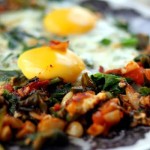This Saturday brunch included a personal-sized baked spinach shakshuka, an Italian-style chopped salad, chocolate chip cookies made with the New York Times’ recipe, and more. Brunch is always a pleasure.
PERSONAL BAKED SPINACH SHAKSHUKA
This was a good excuse to use the little clay crock pots we bought a few years ago in Bulgaria. If you don’t have Bulgarian crock pots, you could use ramekins instead. This quantity made a small serving for two. I’d recommend using the quantities listed below for one person, with either one or two eggs, depending on what you consider a serving.
Our egg yolks came out soft but solid, after 10 minutes or so in the oven. It would be nice to leave them runny, which probably could be achieved by only 1-2 minutes in the oven, or even just closing the pot and letting the hot clay do its work.
I should note that I’m not sure how much the shallot added — if you don’t happen to have one sitting around, using half a purple onion and no shallot might be just as good.
Regarding the cheese, I used a white, braided Georgian cheese that resembles mozzarella, because I happened to have it in the fridge. I think this dish calls for something paneer-like, mild and solid. Feta or Bulgarian cheese could work too, although keep in mind that these cheeses are salty.
100 grams spinach
1/4 purple onion
1 shallot (or use no shallot and 1/2 purple onion)
2 small mushrooms
50 grams hard white cheese
1/8 t dried cumin
salt
pepper
olive oil for frying
Chop the shallot/purple onion into thin slivers, and fry in a bit of olive oil in a thick frying pan. Add the cumin, salt and pepper. Coarsely chop the mushrooms and the spinach, and add to the pan. Stir and cook until the spinach has wilted, then remove from the flame. Chop the cheese into large chunks, then mix with the spinach and pour into the crock pot or ramekin.
Separate the egg whites from the yolks, and pour the whites on top of the spinach — you separate eggs by cracking them, and removing the top half of the shell carefully so that the entire egg doesn’t pour out. The whites will start dripping over the edges of the shell. At this point, I gently hold the yolk in place with my fingers, and let as much white as possible out of the shell. Then pour the yolk into a little bowl, to save it for later, being careful not to slice it on the edge of the egg shell.
Anyway, set aside the yolks, and put the egg-white topped spinach into the oven at 180 degrees Celsius, covering with the top of the pot (if it exists), and let bake for about 10 minutes, until the egg whites are solid. Then pour the egg yolks into the container, and either return to the oven for a minute or two, or cover with the clay top for a few more minutes, until the yolks just begin to solidify on top. If you don’t want runny yolks, leave it in the oven for a few minutes longer.
I should note that what passes for cucumbers in the United States isn’t exactly an Israeli cucumber. Here, the cucumbers are small and full of flavor, so two chopped tomatoes and two chopped cucumbers are more or less equal in volume. Americans, adjust the amount of cucumber accordingly. As always, if you’re making anything out of vegetables in the United States, I recommend using organic, and vine-ripened tomatoes, so that they’ll have some taste.
2 tomatoes
2 cucumbers
1 red pepper
1/2 purple onion
3/4 t dried oregano
3/4 t dried basil
1/4 t dried marjoram (optional)
2 T olive oil
1/2 t wine or sherry vinegar
salt and pepper
Chop the vegetables coarsely. Mix in the herbs, and add the olive oil, vinegar and salt right before serving.
I followed the recipe pretty much word-for-word, although I used only white flour (instead of the two kinds the recipe calls for) and made only half the quantity. It’s still a lot. The recipe calls for letting the dough sit for 24-36 hours, and indeed, it improves with time. We generally make a few cookies after letting the dough sit only 18 hours, on the theory that OK cookies today are better than great cookies tomorrow. Indeed, as economics teaches, the theory holds.
We accompanied our brunch with coffee and bread topped with ketzah (קצח) and roasted vegetables, from the bakery at the Carmelit end of the Carmel market. As the guy at our cheese stand told us, it turns out that ketzah actually translates into English as nigella, but when he told English-speaking tourists that this was the spice in his white Tsfatit cheese, they had no idea what he was talking about. Wikipedia says the spice can also be referred to as black cumin, which seems appropriate to me, since it has an aromatic, cumin-like taste, even though it looks like black sesame seeds. In case you were wondering.




